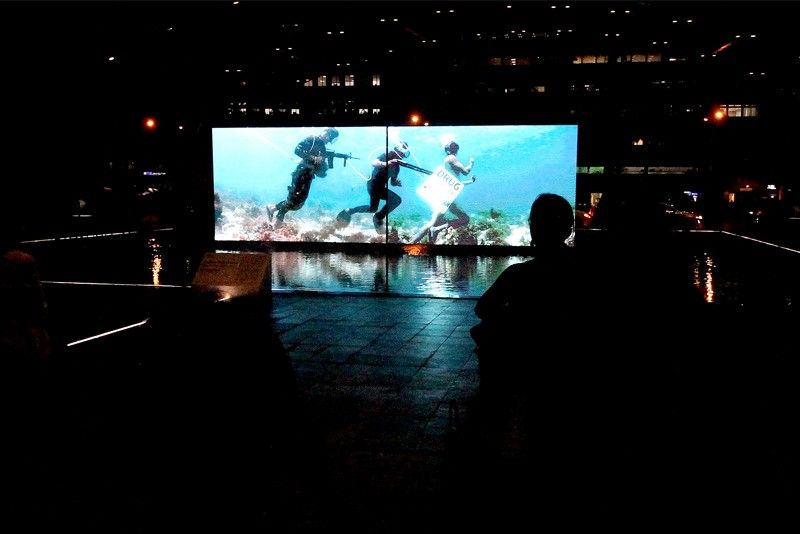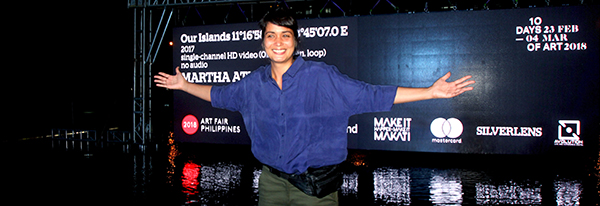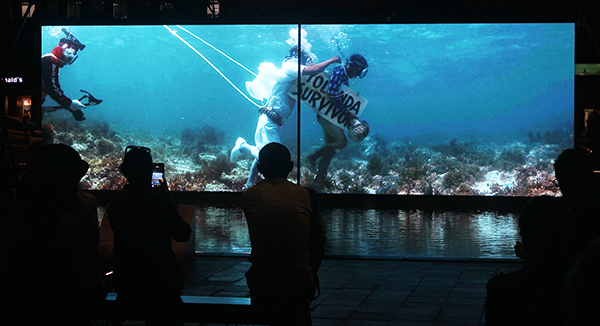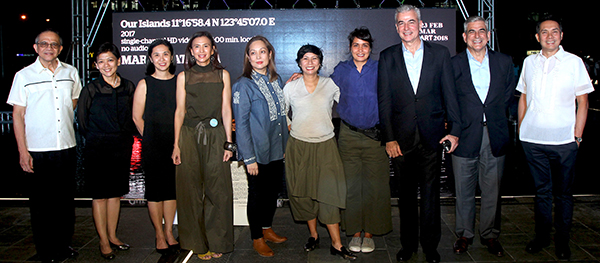Martha Atienza’s video installation intervenes on our own everyday parade


Martha Atienza’s video installation, which won the Baloise Art Prize at Art Basel Basel in 2017, makes its Philippine premiere at the Ayala Tower One and Exchange Plaza.
In the middle of banks, on the stomping ground of businessmen, by the Ayala Triangle park where people in suits eat their lunches in a hurry, there is a slow parade. A man carrying the red-robed Sto. Niño leads an underwater procession followed by a cast of stranger characters: Among them, a man in a red gown ready for his pageant, a migrant lugging a suitcase almost the size of a body, a so-called drug lord being hounded by two armed men, a lone boxer provoking an imagined rival.
Martha Atienza’s video installation “Our Islands, 11°16’58.4”N 123°45’07.0”E” kicked off “10 Days of Art” last Feb. 26, part of Art Fair Philippines’ initiative to bring art into public spaces around Makati. People at the park sit on benches across the screen likely wondering what’s happening.

Dutch-Filipina artist Martha Atienza works with video and taps the capacity of art to prompt discourse and social development.
Having won the artist the Baloise Art Prize at Art Basel Basel in 2017, the installation made its Philippine premiere and will then travel to museums in Seoul, Luxembourg and Brisbane. “But, I daresay,” says Silverlens gallerist Isa Lorenzo, “this is probably going to be the best viewing of it, in the best space.”
Set in Ayala Tower One and Exchange Plaza, the slow-moving spectacle is like a visual foil to Makati’s faster currents. “It’s crazy,” says Atienza. “I think it’s good that we take it to the city. It’s like the difference between day and night. This specific space is the opposite of Bantayan Island. You have all these men in suits walking around, and maybe these are things that they don’t realize. They never think about the fishermen, the farmers, or about what people do outside of their kind of bubble.”
Atienza has herself always been shifting between different places. The Dutch-Filipina artist divides her time between the Netherlands and the Philippines. Primarily using the camera as a medium, as well as the sea and its communities as her subject, Atienza’s works have won her grants and residency programs in Liverpool, Melbourne, Singapore, and New York, lauded for how she uses art as a means to incite engagement, participation, and discussion. Hours before the launch, Atienza also received the Ani ng Dangal award given by the NCCA.

Atienza works with compressor divers and Ati-Atihan dancers to shed light on sociopolitical issues
ranging from the country’s war on drugs to labor migration, and environmental degradation.
“I started (documenting) the Ati-atihan because when I was filming cargo ships and (what the fishermen would do at sea), my images were so boring and so long,” Atienza quips. “Everyone was falling asleep. Once in a while, we needed to laugh. The Ati-Atihan was a good ice-breaker. It was also a way to watch ourselves on the screen, for people to get used to seeing themselves.”
When somebody had asked Atienza if she had a work that represented what was presently happening in the Philippines, it prompted her to revisit the Ati-atihan. An ancient animist festival dating back to the era before the Austronesian migration and Christianized during the Spanish times, the festival is steeped in an excess of imagery, part heathen, part Christian, part mad.
Each year during the procession, the fisherfolk-turned-Ati-atihan dancers engage in roleplay and masquerade, making and donning costumes relating to popular issues and events. Atienza softens the uproar and hysteria of the festival by submerging it underwater, just as the film downplays the graveness of the issues through theatricality and humor.
“It’s the Filipinos’ way of talking about serious things,” says Atienza. “It’s really through humor and I think we should embrace that. That’s the way we communicate.” Issues as grave as the country’s war on drugs resurface, as well as labor migration and the destruction of marine life — concerns faced by the Bantayan community which Atienza has always aimed to give voice to through her work. These are juxtaposed with Pinoy culture icons — gay beauty queens and Manny Pacquiao — we either criticize or celebrate. These characters were chosen by the men themselves who make their own costumes every year.
“My part,” says Atienza “was to film and put it into context. The power of the video camera is when you see yourself, you all of a sudden look at yourself in a different way, then you start looking at your actions and you start getting a new perspective — why did you make that costume?”

Manny Blas, Meean Dy, Dindin Araneta, Trickie Lopa, Rachel Rillo, Isa Lorenzo, Martha Atienza, Fernando Zobel de Ayala, Jaime Augusto Zobel de Ayala, and Bobby Dy
It suggests the capacity of video to engineer a kind of reversal or mirror image. Through Atienza’s role as artist, participant, and interlocutor, she also hints at how the camera and the screen become mediums to see the other or to make us see ourselves as other. Set in Makati, the work now points back to us. “So even though we see this setting as development, maybe it’s not,” says Atienza of the site where her video now plays. “I think it’s a good reminder. Maybe it’s idealistic, but I hope it could change the way people look at their own lives and make a difference.”
As site-specific intervention, Atienza’s work subtly disrupts and prompts us to consider: In the middle of the business district, perhaps we ourselves are engaged in a kind of roleplay. Who is trapped in a manmade panel? What suits, dresses, and costumes do we don in our own everyday parade? Now confronted with environmental and socio-political issues we often leave off-frame, we think, who is living in a bubble? Perhaps the diver-performers caught in a video loop. Or perhaps we, caught in a cycle we can opt to break.



















